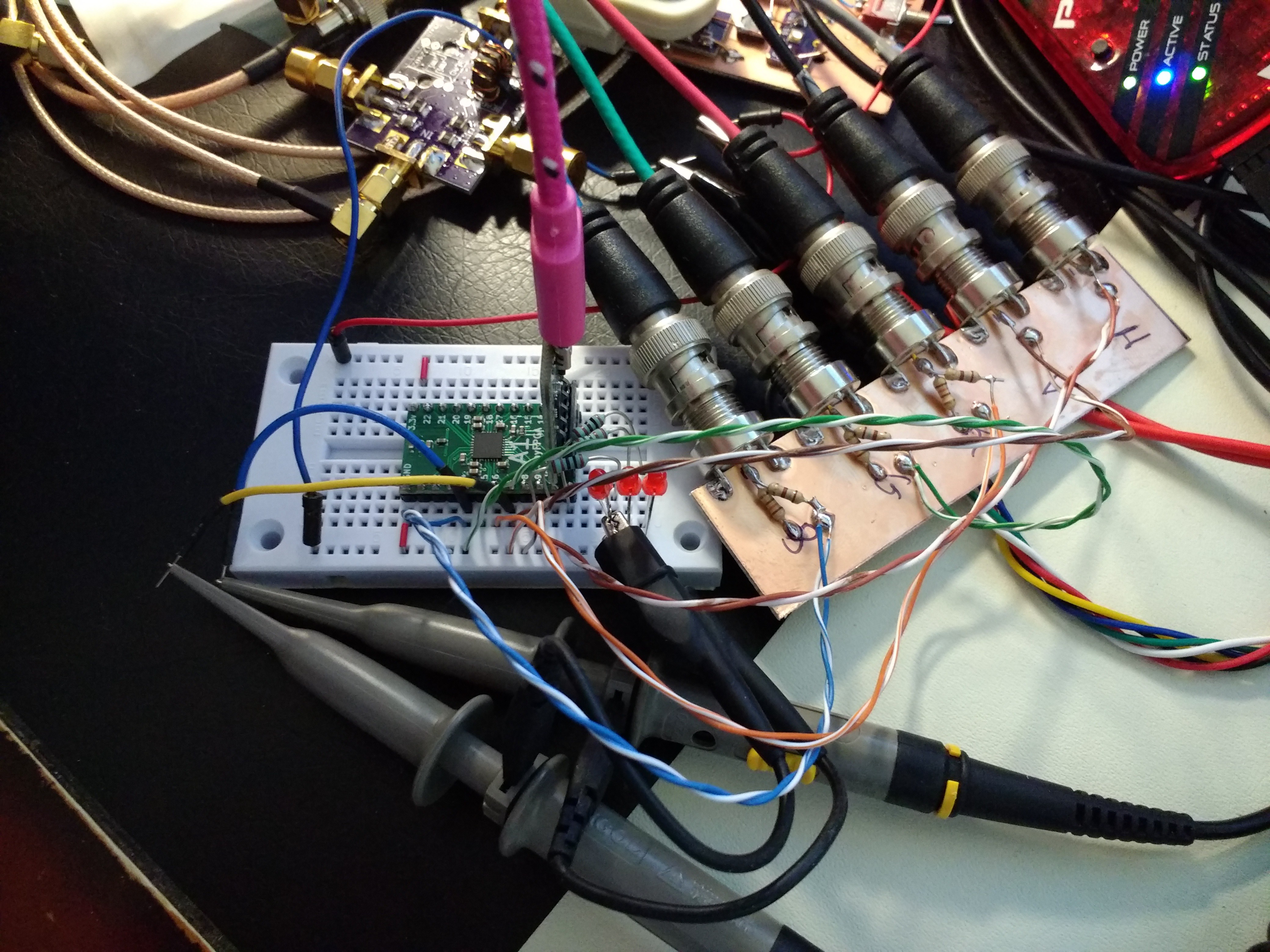I wanted to get started with FPGAs for a long time. Today, it finally happened. I bought a #TinyFPGA A-Series (A1 specifically) on Tindie, and started coding. After a few hours, I came up with a bouncing ball on a VGA monitor (starting from scratch).
I know there are simple VGA examples out there, but I resisted looking at them for the exercise. It's not super-complex, but a lot of things have to be right to get this to work. There are a few issues, mainly about the clock. I used the internal clock source on the FPGA, which isn't very accurate or stable. Additionally, the closest I could get to the proper 25.175 MHz dot clock was 24.18 MHz. The result is a little jitter on the display. I could solve this with an external oscillator, but this was just an exercise.
The hardware is simply the A1 board and six resistors to shift the RGB levels and provide a proper 75-ohm output impedance. I didn't have any VGA connectors around, so I used BNC's and an old-school VGA-to-BNC cable. There are a few in-progress projects in the picture, but you can locate the TinyFPGA and the BNCs. The three LEDs from the example in the TinyFPGA documentation are still in the breadboard :-)

The verilog code could probably be prettied up a lot, but at this point, I'm just excited to have something going. This is sure to give experienced RTL jockeys a good laugh:
module TinyFPGA_A1 (
output pin4_mosi,
output pin5,
output pin6,
output pin7_done,
output pin8_pgmn
);
wire clk;
OSCH #(.NOM_FREQ("24.18") // should be 25.175 - close enough!
) internal_oscillator_inst (
.STDBY(1'b0),
.OSC(clk)
);
parameter ball_size = 20;
reg [9:0] horiz_ctr;
reg hsync;
reg [9:0] vert_ctr;
reg vsync;
reg hblank;
reg vblank;
reg [9:0] row;
reg [9:0] col;
reg dr;
reg dc;
reg [2:0] rgb;
always @(posedge clk) begin
horiz_ctr <= horiz_ctr + 1;
if (((vert_ctr-45) >= row) &&
((vert_ctr-45) <= (row+ball_size)) &&
((horiz_ctr-160) >= col) &&
((horiz_ctr-160) <= (col+ball_size)))
rgb = 3'b100;
else
rgb = 3'b001;
case (horiz_ctr)
10'd16: hsync <= 1;
10'd112: hsync <= 0;
10'd160: hblank <= 0;
10'd800:
begin
horiz_ctr <= 0;
hblank <= 1;
vert_ctr <= vert_ctr + 1;
case (vert_ctr)
10'd10: vsync <= 1;
10'd12: vsync <= 0;
10'd45: vblank <= 0;
10'd525:
begin
vert_ctr <= 0;
vblank <= 1;
if (dr)
row <= row + 1;
else
row <= row - 1;
if (dc)
col <= col + 1;
else
col <= col - 1;
if (row < 1) begin
row <= 1;
dr <= ~dr;
end
if (col < 1) begin
col <= 1;
dc <= ~dc;
end
if (row > (479-ball_size)) begin
row <= 479-ball_size;
dr <= ~dr;
end
if (col > (639-ball_size)) begin
col <= 639-ball_size;
dc <= ~dc;
end
end
endcase
end
endcase
end
wire frame_active = !vblank & !hblank;
assign pin8_pgmn = !hsync;
assign pin7_done = !vsync;
assign pin4_mosi = frame_active & rgb[0];
assign pin5 = frame_active & rgb[1];
assign pin6 = frame_active & rgb[2];
endmodule
If I'm reading the output of the Lattice Diamond software correctly (doubtful), I've used 117 of the 256 available LUT's - less than half. I didn't think about optimizing the code at all - at this point, I wouldn't know exactly where to start.
I am really impressed with how easy this all is. Kudos to @Luke Valenty on a very nice project/product.
 Ted Yapo
Ted Yapo
Discussions
Become a Hackaday.io Member
Create an account to leave a comment. Already have an account? Log In.
This is great! @Xark had previously attempted using the internal oscillator on the A2 for VGA but it seemed like his monitor didn't like it. I'm happy to see that it will at least work with some VGA monitors. Also fun to see what people can do with the teeny-tiny FPGA in the A1. Thanks for sharing your project :)
Are you sure? yes | no
Thanks! It also worked at 26.60 MHz with this monitor, but appeared to tear a little more on the left edge.
Are you sure? yes | no